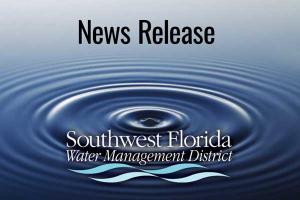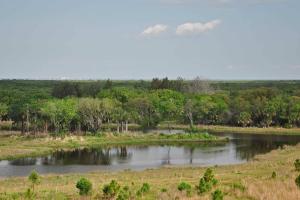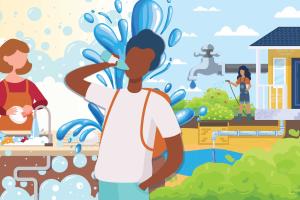Search Content
Displaying results 2641 - 2660 of 5020
From the top: Executive Director Dave Moore, left, and Governing Board former Chair Todd Pressman, right, honor Dick Prey for helping maintain the Withlapopka Community Park. Kim DeVary from Land Resources, left, thanks volunteer Carol Beaton for her work at Chito Branch Reserve. Brandt Henningsen from the SWIM Program, right, and Pressman, left, honor Jessica Welling from Tampa Bay Watch. The Lowry Park Zoo was on hand with native animals for the volunteers to see.…
Governor Ron DeSantis appointed William Hogarth and Johnnie Hall to the Southwest Florida Water Management District's Governing Board. Governor DeSantis reappointed Paul “Jack” Bispham who has served on the Governing Board since 2019. Hogarth represents Pinellas County, Hall represents Polk County and Bispham represents Manatee County.
Hogarth, of Treasure Island, is the former director of the Florida Institute of Oceanography at the University of South…
Left: Donna Holdrege, District administrative supervisor, left, and Mary Torrusio, District senior communications coordinator, second from left, demonstrate a watershed model to students. Right: Dan Wolthuis, District senior heavy equipment operator, talks to students and parents about prescribed fire.
Parents marked the District’s 15th annual celebration of Take Our Daughters and Sons to Work Day on April 18 by bringing their children for tours of District…
The Southwest Florida Water Management District Governing Board Tuesday adopted Fiscal Year 2007 (FY2007) millage rates. The District’s millage rate remains the same as last year for the District’s General Fund. The millage rates for seven District Basin Boards also remain the same. The Coastal Rivers Basin Board lowered its millage rate.Downloadsample projects by county.For the…
Todd Pressman was elected Wednesday by his peers to serve as Governing Board chair of the Southwest Florida Water Management District.Other Governing Board officers selected today include Ronald E. Oakley, vice chair; Hugh Gramling, secretary; and Sallie Parks, treasurer.Chair Todd PressmanPressman of Oldsmar was first appointed to the Governing Board in April 2005, and is also co-chair ex officio of the District’s Pinellas-Anclote River Basin Board. He has also served…
The Southwest Florida Water Management District Governing Board Tuesday adopted its proposed Fiscal Year 2009 (FY2009) millage rates for the General Fund and the eight Basin Boards.The Governing Board adopted a proposed FY2009 millage rate of 0.3866 mill for the District’s General Fund, which is the same as the current fiscal year. FY2009 will run from Oct. 1, 2008, through Sept. 30, 2009.The total proposed FY2009 budget for the District is $375.8 million, 4.9 percent…
Projects of Distinction
The Tampa Bay Regional Planning Council recently recognized the District during its 13th Annual Future of the Region Awards program.
One District Surface Water Improvement and Management (SWIM) project and two education projects were honored during the ceremony, recognizing notable achievements in resource planning and management in the region.
Port Redwing Habitat Restoration/ Fred & Idah Schultz Preserve
The…
Hundreds of volunteers trudged through the mud to get to hard-to-reach places that needed planting.
This September approximately 400 volunteers set out across 32 acres of muddy ground at the Terra Ceia Aquatic and State Park preserves restoration project in Manatee County with one goal in mind: The volunteers were determined to set a new record for the most plants installed during a…
Volunteers participating in cleanup.
More than 50 District employees, Board members and their friends and families were among the hundreds of volunteers taking part in the 21st Annual Hillsborough River & Waterways Cleanup.
This annual event, held in November, is one of Tampa’s largest volunteer activities. Each year, volunteers scour dozens of shoreline locations along the Hillsborough River and connected waterways to pick up litter and remove…
Two equestrian groups and a middle school student are among the volunteers honored Tuesday at the Southwest Florida Water Management District’s Governing Board meeting in Brooksville.The volunteers, who take part in the District’s Land Resources Volunteer Program, received the President’s Volunteer Service Award, a national honor that recognizes volunteer dedication and signifies that each volunteer has served the community and country with distinction.The…
The Rock Ponds Ecosystem Restoration Project has become a showcase project for habitat restoration through community partnerships. That’s why the project was just recognized by the Tampa Bay Regional Planning Council. The District won first place in the Natural Environment category in the Future…
Members of the Withlacoochee River Basin Board and the Lake Panasoffkee Restoration Council recently surveyed the progress of the four-step, multimillion dollar Lake Panasoffkee restoration project.
The Lake Panasoffkee restoration project involves dredging approximately 8.2 million cubic yards of sediment from the lake, which will improve fish habitat, restore the historic lake shoreline and improve navigation. The project will also restore approximately 920 acres of…
Water supply refers to the source and process of providing water to different users. The “source” refers to where the water comes from. Sources of natural fresh water may include groundwater or surface waters, such as lakes, rivers, ponds or streams.
According to the Florida Department of Environmental Protection, surface water was the largest source of fresh water in Florida until 1980. After 1980, groundwater became…
At its August 16 meeting, the Southwest Florida Water Management District’s Withlacoochee River Basin Board adopted a fiscal year 2005 (FY2005) millage rate of 0.265 mill, which is the same as the current fiscal year.The budget forFY2005 is $11,312,338, which is an increase of $6,769,805 over the approvedFY2004 budget. The main reason for this major budget increase is because the District will receive a $4.3 million state appropriation and anticipates receiving $1…



